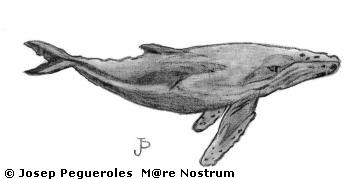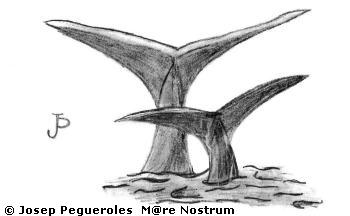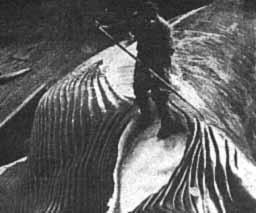THE BIG WHALES
by Josep Pegueroles


The whales are the
largest mammals on Earth. They are gigantic and fascinating but we have only learnt the
way of killing them.
All that we have learnt about them has been used against them. For example, we have learnt
that if we harpoon a whale-calf, all the adults surround it to protect it. This way is
easier to hunt the adult whales.
What we don't know is that those groups are formed by individuals with a huge and complex
brain, and that they are united mutually by narrow social links. For the man they have
been only gigantic meat and fat bulks from which we may extract oils and chemical
products.
During years they have been pursued along all seas and oceans, arriving to decimate its
population. No one was worried about the knowledge and information we could get from these
interesting animals.
Always we have believed that we were evolutively over them, but when we decided to study
them we realize that they are far more intelligent than we thought first, and then we
arrive to this sad question: Is it too late for them to recover ?
Until we have not been able to dive in the sea, we have not realized the fact that the
world of the whales is incredible and wonderful, and once in this habitat, we are still
astonished as we understand that we have only started to glimpse the secrets of the
whales.
 As we have said, the whale is the largest
living animal today, there is no discussion about this. The common blue whale can measure
between 75 and 90 feet long, and has a weigh of about 150 to 200 tons. As we have said, the whale is the largest
living animal today, there is no discussion about this. The common blue whale can measure
between 75 and 90 feet long, and has a weigh of about 150 to 200 tons.
Its heart is the size and weight of a small car and its body is covered by a thick layer
of fat that allows its body temperature to be kept between 36 and 37 degrees Celsius, even
in very cold waters.
The fat of the whales is covered of a delicate skin layer together with the epidermis.
This segregates an humidifying substance that favors its hydrodynamics.
Its body is elongated. The two upper extremities are transformed into fins. The other
extremities have disappeared. Its body finishes in a great horizontal fin, endowed of a
potent musculature, what permits the whale to reach, sometimes, speeds of 25 to 35 mph.
Except in the blue whale, which has certain flexibility, the cervical vertebrae of the
whales are welded to the cranium. Some whales have an small dorsal fin, the one which
sometimes is reduced to a small comb, or disappears as in the gray whale.
These large mammals, having large lungs, breathe thanks to the nasal orifices that they
have in the upper part of the head, which they tightly close when they are submerged,
opening them when return to the surface to breathe, producing the characteristic snort of
the whales.
Some species of whales can stay submerged for one hour, reaching depths of 3000 feet.
 The whales fed in different ways,
depending on the species. Some have teeth as the white whale or the dolphins, which feed
on large preys as the gigantic squid, which are trapped several hundred feet underwater,
after being detected, in the most absolute darkness, with a sonar like organ located in
the head of the whale. The whales fed in different ways,
depending on the species. Some have teeth as the white whale or the dolphins, which feed
on large preys as the gigantic squid, which are trapped several hundred feet underwater,
after being detected, in the most absolute darkness, with a sonar like organ located in
the head of the whale.
Other species of whales do not have teeth, being substituted by something called
"beards" or "whales". Those beards are formed by cornea plates
attached to the upper jaw, and act as a big filter, which the whale uses to trap its
preferred food, the plancton, the "krill" and other small crustaceans.
The whale swallows tons of sea water, then closes its mouth and draws all the water from
the mouth, filtering it with the beards. Large quantities of food remain trapped in the
"beard", being withdrawals by its huge tongue.
Some species of whales without teeth have shorter beards. They fed by searching the mud of
the bottom of the sea with the opened mouth, filtering this way the small beings hidden in
it: worms, molluscs and small crustaceans. This type of whales live generally near the
coast.
About the blue whale. The female whales are always larger than the males, and tend to live
in couples or small groups, and are paired in temperate or warm seas. The whale-calves are
capable of swimming upon born. They fed of the milk of the mother, (very rich in fats),
and can grow at a rate of 50 kg. daily.
The gestation of the whale calves takes about 10 to 12 months. These calves, that weigh
about 2 tons upon born and measure about 14 feet, grow very fast, quitting of mother's
milk between 7 and 12 months after, depending on the species and of the state on the calf.
During this time the calf accompany their parents in the migrations, being protected by
all the components of the group, independently of their kinship. Under this general plan
are outlined the standard behavior, which can differ somewhat from one species to another.
The sexual maturity of the whales tends be between 10 or 15 years, though is noted lately
a reduction in the age of the sexual maturity, after the almost annihilation of the
populations of whales by the intense hunt. The scientists believe that this precociousness
is caused by the reduction of the species, which provokes a faster growth of the young
calves.
It is said about the whales, that they are real singers. They issue sounds (in different
frequencies), vibrations and sighs.
It has been discovered that the humpback whale issues a real song that it can be
lengthened for hours. These songs are composed by refrains that are repeated continually,
though they are being added variations.
Each specimen has a different voice, but the songs are common to the group. These songs
can be heard to 20 miles of distance. The ones who had heard whale songs remain astounded,
since they say that these songs are capable of penetrating in the human feelings. If we
should have heard these songs before perhaps our way to treat them would have been
different.
 The greatest threat of the whales is,
doubtless, the man. As with other so many species, we have not stopped the killing on time
and we have almost extinguished them, provoking a slaughter about which we can't feel
proud precisely. The greatest threat of the whales is,
doubtless, the man. As with other so many species, we have not stopped the killing on time
and we have almost extinguished them, provoking a slaughter about which we can't feel
proud precisely.
This does not mean that we can't use this biological resource, but only if we take care of
it at the same time, because like other natural resources within our reach, this one is
already exhausted.
Thanks to many scientific and to other disinterested associations, the protection measures
adopted by the Whale International Commission (which is formed by more than 50 whaler
countries) permit the maintenance and even the development of certain populations of blue
whales.
Its purpose is not so much to protect the whales, but be assured the future business in
the long run, but this is a first step in the conservation of this animal.
As an agreement made some years ago, the captures were suddenly reduced, more than by the
laws, by the disappearance of these animals. Alone in 1960s there were killed more than
60.000 animals.
Perhaps the luck of the whales resides in the chemistry industry, that is synthesizing
products that previously were elaborated with the whales.
Other of the factors that collaborated to this conservation were that in 1975, the own
W.I.C., pressed by the increasingly numerous world ecological associations, quitted of
being a whaler club to become a genuine ecologist association.
It was not until 1986 in which the own W.I.C. approved the international prohibition of
marketing the products derived from these animals. Unfortunately, not all the countries
accepted this decision, Norway, Iceland, Korea and Japan just didn't stop killing whales.
Norway and Japan kill about 600 to 650 whales every year "for scientific
purposes".
Nobody can predict where the investigation of those wonderful animals will lead the
humanity. The human wit, in its highest expression, has not achieved to create nothing so
wonderful and complex as the whales. Instead, we have in our hands the power of letting
them exist. The decision that we take can affect us more than the WHALES...

© Original text and Drawings: Josep Pegueroles 1996
|